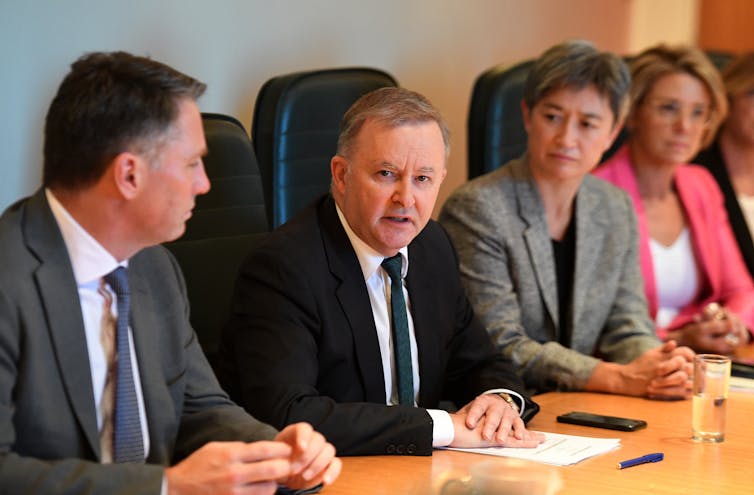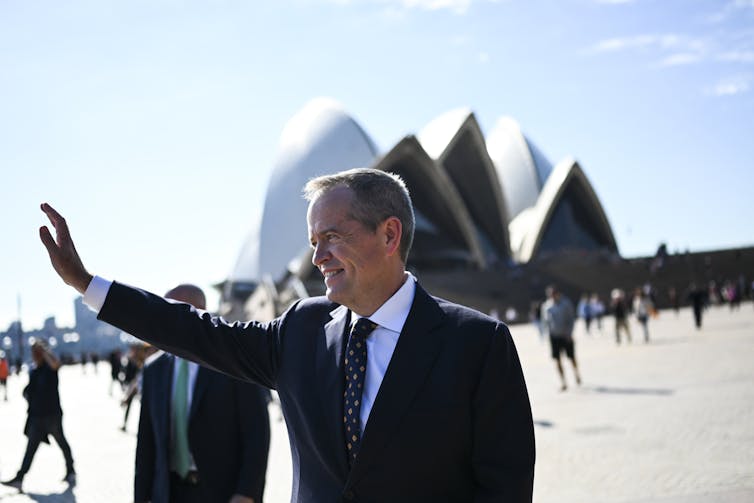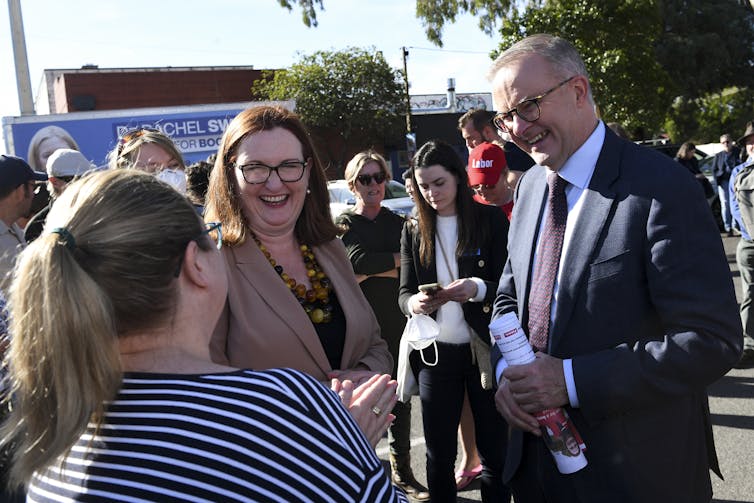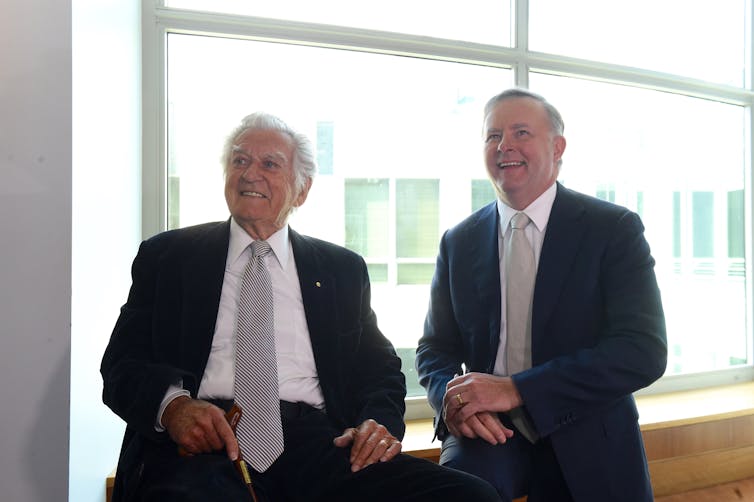By Paul Strangio*
Karen Middleton’s 2016 biography of Anthony Albanese concludes with a speech he made that year, on the 20th anniversary of his election to parliament.
“I’m patient”, he told his clapping audience, “I’m patient — I’m a Souths fan”. The South Sydney Rabbitohs are the Rugby League club Albanese supports, which for the greater part of his adult life was notorious for its competitive under-performance.
The audience realised, of course, that in proclaiming his long-suffering dedication, Albanese was really alluding to his political vocation and his other underachieving “tribe” — the Labor Party.
Albanese’s journey in Labor politics has indeed been long and arduous. He was still a boy when he began accompanying his mother and grandparents to local branch meetings of the Labor Party; he remembers handing out for Gough Whitlam in 1972 when only nine. He formally joined the ALP as a teenager. Up to his ears in student Labor politics as an undergraduate, upon leaving Sydney University he went to work for the elder statesman of the New South Wales left faction, Tom Uren. By his mid-20s he was assistant secretary of New South Wales Labor, and won the seat of Grayndler for the ALP in 1996 on his 33rd birthday.
Even his path to leadership has been unusually slow. One has to go back to the middle of last century for an opposition leader who was older (56) and who had served for longer in the parliament (23 years) when first elected to that position.
His wait for the chance to become prime minister has been of far longer duration than most of Australia’s recent national leaders. Kevin Rudd, Julia Gillard, Malcolm Turnbull and Scott Morrison averaged only around a decade between entering parliament and attaining office. For Albanese, it will be a quarter of a century if Labor wins Saturday’s election.
To continue the slow burn theme, if Albanese is to be believed, his ambition for leadership formed late. Those who reach leadership positions are typically consumed with an aspiration for the top job from early in their parliamentary careers — if not before. They are fuelled by a sense of their own prime-ministerial destiny.
Albanese is different. On his telling, it was only in 2013, on the defeat of Rudd’s second government, that he first entertained thoughts of becoming leader. Until then he had contented himself with the role of “counsellor and kingmaker”.
And still he had to wait. Despite winning a comfortable majority of the rank-and-file vote, he narrowly lost the leadership to Bill Shorten in 2013 because several of his left faction Caucus colleagues defected to support Shorten. Albanese then had to stay his hand in 2016 when Shorten’s better-than-expected performance at that year’s election insulated him from a leadership contest. When Shorten seemed poised for victory in 2019, Albanese must have figured his chance to be party leader had passed. But then came “Morrison’s miracle” and Albanese emerged as the only candidate to succeed Shorten within a demoralised Labor caucus.
Playing the long game has also been the hallmark of Albanese’s leadership over the past three years. Beginning with “listening tours” of the regions where Labor badly faltered in 2019 — most notably in Queensland — it has been painstaking and unglamorous graft.
As journalist Katharine Murphy has observed, to his detractors his approach has been akin to a campaign of “attrition”. Those critics have harped on the theme of his leadership being a small target and his program prosaic. This is not how Labor wins office, they have insisted. Drawing on a sample size of three — the number of times Labor has claimed government from opposition since the end of the second world war under the leaderships of Whitlam, Bob Hawke and Rudd — the critics have argued the template for Labor success is a bold, transformative reform program and a charismatic, popular leader. Under Albanese, they complain, Labor has neither.

One can quibble at the edges of the critics’ reading of history. Though Whitlam unquestionably heralded an expansive reform program in 1972, the Labor Party was sufficiently concerned about his image that it launched an unprecedented advertising blitz to humanise him in the eyes of the public.
When Hawke won in 1983, Labor’s program for government was all but subsumed by the leader’s messianic appeal as encapsulated in the slogan, “Bob Hawke Bringing Australia Together”.
Rudd’s victory in 2007 was on the back of a campaign in which Labor selectively staked out policy differences with the Coalition. The nerdy Rudd painted himself as more of a fiscal conservative than John Howard, and was reassuringly perceived as a kind of youthful version of the prime minister. In short, the idea of Labor relying on larger-than-life platforms and leaders to win government is exaggerated.
This is not to deny that under Albanese, Labor is running on a considerably less daring agenda than it did in 2019. Indeed, it is an irony — or confirmation that ideological tags count for nothing in the contemporary Labor Party — that the right faction’s Shorten campaigned on an aggressively redistributive program spiced by “class war” rhetoric about the “big end of town”. In contrast, the left faction’s Albanese has abandoned those redistributive measures and has been emollient in his language towards business.
The plan to curb franking credits was first to go under Albanese, followed by the dumping of plans for changes to negative gearing, capital gains and, most recently, family trusts. As well, Labor has announced that in government it will not repeal the third tranche of the Coalition’s tax cuts that benefit high income earners. Simultaneously, Albanese has portrayed himself as a friend of aspiration. He believes, he says, in an Australia “where nobody is held back and nobody is left behind”.
To be fair to Albanese, it makes sense Labor changed tack from 2019. The party’s review of that defeat blamed it on “a cluttered policy agenda that looked risky and an unpopular leader”. In a speech to the National Press Club on the release of that review, Albanese indicated he had got the message: “too many people were confused or even frightened by our policies”. Elsewhere, he has pointedly noted none of Labor’s past successful opposition leaders campaigned on increases in taxes.

If there is a playbook to Albanese walking away from the Shorten program, then it is from the other side of politics. In 1996, heeding the lesson of John Hewson losing the unlosable election three years earlier on a radical neoliberal manifesto headlined by a new tax (the GST), John Howard renounced the GST as well as other contentious policies from Hewson’s Fightback! program. Howard determinedly narrowed the points of difference with Prime Minister Paul Keating, driving the latter to distraction.
Albanese has been unabashed about his strategy of not rejoining the battles of 2019, declaring he has no intention to “relitigate the past”. To those who cavil that Labor has abandoned its ideals by dropping the redistributive policies he has been equally blunt: “One of my Labor principles is for Labor to win elections”. This might not be as caustic as Whitlam’s famed put-down of the Labor hard left: “Only the impotent are pure”, but the point is fundamentally the same. To change the nation, Labor first has to win at the ballot box.
The abandonment of the Shorten-era revenue measures has curtailed Labor’s scope for campaign initiatives. According to the Coalition, Albanese is like a thief in the night, trying to steal his way into office on a meagre policy program. This is largely unfair. Beginning at a leisurely pace, Albanese gradually accelerated the roll out of policies.
Labor entered the campaign proposing, among other things, major investments in aged care, childcare and social housing, manufacturing renewal, greater support for TAFE and universities, an upgrade of the electricity grid, a national anti-corruption commission and implementation of the Uluru Statement. During the campaign, this program has been buttressed by further promises in areas like health, housing and pay equity for women workers.
Another conclusion of Labor’s review of its 2019 election campaign was that there was an absence of a clear narrative binding together the party’s policies. Albanese too has struggled in that space. In the second half of 2021, he seemed to be feeling his way there by talking about the reconstructive role of government following the crisis of the pandemic. This was potentially redolent of a great Labor reformist era (post-war reconstruction) and a sharp contrast to Morrison’s “can-do capitalism” mantra. Yet his prosecution of the case for the transformative power of government has remained inchoate.
Albanese’s predilection, as exposed on the hustings, for wandering into verbal marshes has not helped either in providing coherence of theme. But the lack of a compelling story line also goes back to the abiding caution of his approach.
The party’s policy on a 2030 carbon emissions reduction target is an illustration. This is another area where Labor kept its powder dry, delaying the release of its target until after the Glasgow Climate Change Conference. When Albanese finally announced a reduction target of 43%, it was almost as if the policy dare not speak its name. He declared it “a modest policy. We do not pretend it is a radical policy”. Hardly the inspirational stuff of “the great moral challenge of our time”.
Making amends for the disappointment of 2019 brings us squarely to the subject of leadership. If Shorten was a millstone on Labor’s vote, a perusal of opinion poll leadership ratings indicates Albanese, though not popular, has not been subject to anything like the antipathy that dogged his predecessor.
In the first half of this year, his leadership ratings edged into positive territory and, unusually for an opposition leader, he was nipping at the heels of the incumbent on the question of preferred prime minister. This was a good place to be.

Probably the most consistent take-out from the leadership polling over the past three years, however, is that Albanese has not made a major impression on the public. The relatively high number of respondents who have nominated “don’t know” when asked to rate his performance has been an indicator of this. The pandemic is one reason Albanese remained indistinct in the electorate’s mind. For stretches of the past parliamentary term, and particularly during 2020, he struggled for oxygen.
Yet undoubtedly the tepid response towards Albanese is also a function of the fact he has bent over backwards to be a non-threatening rather than arresting figure. For someone once styled as a warrior of the left, there has been nothing remotely incendiary from him.
That Albanese has journeyed a long way from his pugilistic younger days is a sign of maturity. But the charisma he displayed as a firebrand student politician has also leached away. He presents as a slightly rough-hewn, inoffensive type, workmanlike rather than exceptional. One senses he is more visceral than cerebral, with reserves of emotional intelligence. Colleagues testify that authenticity and decency are his defining attributes: a shorthand way of saying he is the antithesis of Morrison.
Altogether, Albanese’s is an unusually modest persona for an aspiring prime minister, which goes with his insistence he never had a sense of entitlement to leadership. At the same time, there is a core of resilience and self-belief. His inner strength is rooted in his hard scrabble backstory to which he routinely harks back. This is the story of being brought up as the only child of a single mother and invalid pensioner in council housing. His mother’s struggles are the lodestar of his political vocation.
In another way, though, Albanese was blessed as a child. Like past Labor luminaries, Whitlam, Hawke and Keating, he was the recipient of maternal special investment: what he remembers is his mother’s “absolute unconditional love” for him.
While he might not have believed it was his destiny to be prime minister, his mother harboured that ambition for him. Middleton’s biography records that she “believed he could go far — as far as a person can go in the Australian political system”.
What sort of prime minister can we expect Albanese to be if he wins power on Saturday? He has referenced Hawke and, to the gall of Liberals, even invoked Howard as prime ministers he will take a leaf from. The gold standard of modern Labor prime ministers, it is hardly surprising that Albanese looks to Hawke as a role model. He says that, like Hawke, he will govern by consensus, bringing business, unions and civil society together.
The transactional business of forging networks of support is second nature to Albanese: a craft he mastered as a left faction operative in the hostile environment of the right dominated New South Wales Labor Party.
There is evidence of his capacity for wrangling a middle ground. As leader of the House of Representatives during Gillard’s prime ministership, he was integral to the functioning of Labor’s minority government by closely liaising with the crossbenches. Gillard later remarked: “Albo is a very persuasive person. He’s good at talking people into things”.

While Albanese’s leadership style over the past three years has largely escaped analysis, it is notable he has mostly kept Labor united in common purpose. The walking away from the redistributive policies of the Shorten era required extensive consultation to work through the changes within the parliamentary party and beyond.
In the end, the result was achieved with surprisingly little rancour. Albanese’s collaborative abilities are also attested to by the strong leadership team he has assembled around him. In addition to his deputy, Richard Marles, and Labor’s talented shadow treasurer, Jim Chalmers, that leadership group includes Katy Gallagher, Mark Butler, Kristina Keneally, Penny Wong and Tony Burke.
Like all Labor leaders since Rudd, Albanese insists he has learnt the lessons of the dysfunction of that period of government. He will observe “proper” processes allowing genuine debate in Cabinet. Albanese’s team approach is a welcome contrast to the Coalition side, with Morrison giving the impression of running the show himself. If elected, Albanese’s ability to orchestrate consensus will hold him in good stead for tackling thorny policy challenges of which there will be many ahead.
Still, questions linger about whether Albanese has the stuff to be a substantial prime minister. Although a gifted transactional politician, does he boast the erudition and imagination to meaningfully shape the nation? He has demonstrated a flinty pragmatism over the past three years, but less certain is whether he has the driving sense of purpose required to achieve hard-fought reform.
And, like the best leaders, has he the ability to modulate his approach? Can he switch to a more dynamic galvanising mode of leadership or will the circumspection that has defined him in opposition shackle him in government? On the other hand, just maybe his unassuming leadership will provide for a dogged but conscientious form of government that suits Australia’s purposes.
With Labor enjoying a substantial lead in the opinion polls, Albanese’s patience looks set to be rewarded on Saturday. If the polls are right, on two-party preferred terms, the ALP is on track to achieve at least as handsome a victory as when the party won office in 1972, 1983 and 2007. Albanese will have defied the critics and bent the template of how the ALP wins government from opposition. Non-heroic in leadership style, he will nonetheless be celebrated as a Labor hero.
But there remain gnawing fears in the Labor camp that a low primary vote, fickle preference flows and a patchy swing might yet deny them majority government. Should a hung parliament result from Saturday’s contest, Albanese’s persuasive capacities will be tested immediately in wooing the crossbenchers. The probability is that in any negotiations he will have a stronger hand than Morrison because of an edge in numbers and the fact he is unencumbered by the same baggage as the prime minister.
It will be a final minor delay in Albanese’s protracted journey to the political summit.![]()
*Paul Strangio is Professor of Politics at Monash University This article is republished from The Conversation under a Creative Commons license. Read the original article. Today we are running two longer articles looking at the men who are vying to be the next Australian prime minister. You can read Michelle Grattan’s profile of Scott Morrison here.
6 Comments
Why do I still think that Labour in Australia, is always in a flux of change.
... I don't know why you think that ... Albie's been head honcho since Electric Bill departed , after losing the last election ...
Keep in mind that Australian politics sits to the right of NZ politics - in other words
1. Australian Greens has more in common with NZ labor
2. Australian labor has more in common with the Nationals
3. Liberal/ National Coalition - resemble the current US Republican party (ie they give trump a run for their money) - ACT and NZ first would be considered centre left of the LNP
4. One Nation - wouldnt have been out of place in Germany in 1939.
There is no party like the NZ greens in the Australian Parliament.
You see into a nation's soul at an election. The average Australian "knockabout larrikin" image is relaced with a deeply conservative, religious one. The treatment of refugees on Manaus and Christmas Island is an example is a disgrace.
Australia is a Western equivalent Saudi Arabia, high standard of living from a natural resource and a woeful human rights record.
I hope Albanese get's in, he seems like a decent human. It's long overdue.
You could be right about it being a disgrace. Alternative solutions welcome that do not descend into all illegals are welcome or all illegals who can afford the pirates and survive the ocean are welcome. But I'm content to be proved wrong. However what is always missed is that Manus (Manaus is a city up the Amazon) is as near to a Garden of Eden paradise as any place on earth. As my wife who has reasons to be biased against the place says: the bluest ocean, the most perfect of beaches and the greenest vegetation you can find anywhere. The ocean full of fish, the land rich in tropical fruits - only drawbacks are malaria and absence of a welfare state. When my daughter was living in Manus she and her family walked to the town while those applying for refugee status had a bus, her family had to build their houses themselves but those potential refugees had housing built by Australia govt.
My bad, yes Manus! I actually meant Nauru! The mental health and suicide stat's are truly horrendous, no civilised person would be comfortable their cuntry was responsible. That's why I can never take an Australian seriously.

We welcome your comments below. If you are not already registered, please register to comment.
Remember we welcome robust, respectful and insightful debate. We don't welcome abusive or defamatory comments and will de-register those repeatedly making such comments. Our current comment policy is here.